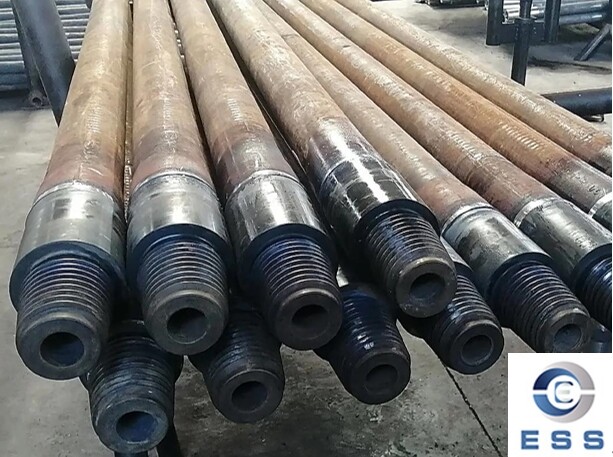
Reasons for magnetization of the drill
pipe
As an OCTG pipe, the
drill pipe is often affected by the geomagnetic field or other electromagnetic interference
during exploration operations, resulting in magnetization. If this
magnetization is not eliminated in time, it will cause interference in the
exploration data, affecting the accuracy and reliability of the exploration
results.
Common demagnetization methods
1. Alternating current demagnetization
method
Use a high-frequency AC power supply to
generate an alternating electromagnetic field, so that the magnetic molecules
inside the drill pipe move with the change of the electromagnetic field,
disrupting the orderly arrangement of the magnetic domains to achieve
demagnetization. During operation, immerse the drill pipe in a demagnetization
tank containing demagnetization liquid, connect a high-frequency power supply,
and conduct electricity through the demagnetization liquid to allow the drill
pipe to be fully affected by the electromagnetic field.
2. DC demagnetization method
With the help of a DC power supply, a
magnetic field in the opposite direction of the residual magnetism of the drill
pipe is generated in the demagnetization coil, and the current is gradually
reduced to make the magnetic domains in the drill pipe tend to be disordered.
The drill pipe needs to be placed in a DC demagnetization coil, and the current
is slowly adjusted to zero after the power is turned on.
3. Demagnetization method using AC
demagnetizer
Use AC demagnetizer to generate alternating
magnetic field, place the drill pipe in its effective magnetic field range,
such as passing through the center hole or between the magnetic poles, start
the demagnetizer and adjust the magnetic field strength and frequency to make
the magnetic domain arrangement of the drill pipe disordered, and the magnetism
weakened or disappeared.
4. Heating demagnetization method
According to the Curie point
characteristics of magnetic material, when the drill pipe is heated to a
temperature close to or exceeding its Curie point, the internal magnetic domain
structure is destroyed due to the intensification of molecular thermal motion,
and the magnetism is weakened or disappeared. The drill pipe can be evenly
heated by oxyacetylene flame, medium frequency induction heating equipment,
etc., and naturally cooled after reaching the corresponding temperature.
5. Demagnetization by tapping
By using tools such as sledgehammers to tap
evenly and moderately along the length of the drill pipe, the orderly
arrangement of the magnetic domains inside the drill pipe is disrupted by
mechanical impact force, so that the magnetism is weakened or eliminated, but
care should be taken to avoid excessive tapping to damage the drill pipe.
6. Vibration demagnetization method
Use equipment such as a vibration table to
make the drill pipe vibrate continuously, or use pneumatic or electric
vibration tools to vibrate the drill pipe locally in sections, so that the
magnetic domains inside the drill pipe are disordered due to energy excitation,
and the orderly arrangement of the magnetic domains is destroyed to achieve
demagnetization.
Evaluation of demagnetization effect
In order to ensure the accuracy and
reliability of the demagnetization effect, it is necessary to test and evaluate
the drill pipe after demagnetization. Common evaluation methods include
magnetometer testing and data processing. The magnetometer test can obtain the
magnetization degree of the drill pipe, and data processing can finely process
the exploration data to eliminate potential interference factors, thereby
obtaining more accurate and reliable exploration results.
Conclusion
Drill pipe on-site demagnetization is a
commonly used demagnetization treatment method in exploration operations, which
can effectively eliminate the interference of drill pipe magnetization on
exploration data. By understanding the causes of drill pipe magnetization,
demagnetization methods and evaluation of demagnetization effects, we can
better master the drill pipe demagnetization technology and ensure the accuracy
and reliability of exploration data.
Read more: Size of Drill Pipe or Advantages & Disadvantages of Oil Drill Pipe













 Eastern Steel Manufacturing Co.,Ltd not only improve product production and sales services, but also provide additional value-added services. As long as you need, we can complete your specific needs together.
Eastern Steel Manufacturing Co.,Ltd not only improve product production and sales services, but also provide additional value-added services. As long as you need, we can complete your specific needs together.










